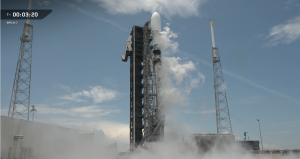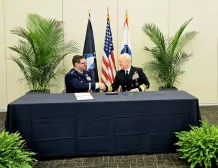Space Force unveils highly anticipated commercial strategy, seeking to employ ‘hybrid’ architectures

COLORADO SPRINGS, Colo. — The Space Force on Wednesday released its much-anticipated Commercial Space Strategy, pushing the service’s plans to field “hybrid space architectures.”
The new document expounds on the Space Force’s previous assertions that it will integrate commercial space solutions into military architectures “wherever possible” as a way to augment or supplant current capabilities. The guidance indicates that the branch is looking for a range of “goods, services, and activities that support and integrate into a multifaceted hybrid space architecture.”
During his keynote speech at the annual Space Symposium on Wednesday, Chief of Space Operations Gen. Chance Saltzman noted that the Space Force has become comfortable with using commercial capabilities in order to add capacity, but has not effectively integrated those technologies into its force design.
“The Commercial Space Strategy is not a panacea. It does not provide all the answers, but I do think it frames the discussion that must take place,” Saltzman said. “It sets the conditions for productive collaboration and it starts the critical processes needed to accelerate the purposeful pursuit of hybrid space architectures.”
The strategy comes months after Saltzman announced he had sent an early draft of the document back to the drawing board for revision. He emphasized that the strategy could not just be “aspirational” discussions, but required concrete definitions, examples and actionable guidance for the commercial industry.
Now, the 19-page strategy details four lines of effort — each with an immediate goal and offices assigned to oversee them — as well as the four criteria the Space Force will consider when deciding when and how to leverage commercial space technology.
While the strategy does not provide specific details about how much money is available to integrate commercial space technologies, Saltzman emphasized that “effective integration will only come about with a common understanding of our priorities, the missions where we need help, our proposal evaluation criteria and clear definitions of terms to enhance that collaboration.”
The directive comes on the heels of the Defense Department’s separate Commercial Space Integration Strategy, which was released last week. While the Pentagon’s strategy outlines the policy and structural guidelines for the entire department, the Space Force’s document focuses on service-specific use cases for commercial technology integration and provides criteria for mission areas and desired end states.
As detailed in the strategy’s second line of effort, “Operational and Technical Integration,” the Space Force wants to “operationally integrate commercial space solutions into a hybrid space architecture.” It also identifies and prioritizes seven mission areas where commercial integration is possible, including the potential capabilities that the Space Force is seeking commercial support for.
At the top of the Space Force’s list is satellite communications, and the service is looking for commercial tech that will increase and improve data transport “speed, capacity, agility, flexibility, reliability, and/or resiliency” for those missions.
Second is space domain awareness, where the Space Force wants capabilities from the commercial sector that “contribute to the holistic generation of SDA,” the strategy states.
New mission priority areas where commercial technology could be integrated, according to the service, include tactical, surveillance, reconnaissance and tracking (TacSRT); space-based environmental monitoring (SBEM); positioning, navigation and timing (PNT); and space access, mobility and logistics (SAML).
Cyberspace ops and command and control are included in the strategy’s list, as well.
In addition, the Space Force is seeking hybrid solutions for what it is calling “space mission enablers” — or capabilities that are essential to space operations and span across multiple mission areas. Those could include constellation management, artificial intelligence, ground support and more.
The strategy calls for both the Space Force’s force design and planning, programming, budgeting and execution (PPBE) processes to include more commercial space solutions, indicating that funding “will be allocated based on the strategic importance and urgency of missions within the USSF and priority will be given to mission areas critical for enhancing national security.”
In order to guide the Space Force’s decision-making when evaluating mission areas and commercial technologies that could be integrated into government architectures, the strategy includes four consideration criteria: operational utility, feasibility, resilience by design, and speed to fielding.
“As we work these lines of effort, we will have to make tough choices about where to place our precious resources,” Saltzman said. “There is never enough money to go around, so we will prioritize and scrutinize our investments. We are in an era of constrained resources and we are going to have to make trades between what we buy and what we build.”
Broadly speaking, the strategy’s remaining three lines of effort indicate that the Space Force plans to improve its engagement and collaboration with the commercial space sector.
For example, the document calls on the service to develop “a comprehensive understanding of the commercial sector’s innovative culture, shorter development timelines, and a burgeoning array of commercial space solutions to the greatest extent practicable.”
To do so, the Space Force will improve its overall awareness of commercial tech, identify requirements that can be met by commercial solutions during the force design process, and look for opportunities where guardians can integrate into the commercial realm to build mutual understanding.
The service is also tasked with establishing a process to improve how it shares threat information — including situational awareness and cybersecurity risks — with the commercial sector across multiple classification levels. The strategy notes the Space Force will actively work to reduce overclassification and other barriers that inhibit accurate and timely information-sharing.
Lastly, the Space Force is looking to establish a formal process to evaluate commercial technologies in order to identify potential capabilities and services that can meet requirements, according to the strategy. That includes tech from both traditional and non-traditional companies.
“We must continuously assess the future operating environment, what missions will be needed in what we need to perform, what threats we will face and what technologies we can bring to bear to meet our operational challenges,” Saltzman said. “We know we will need substantial support from the space industry to answer these vital questions.”






